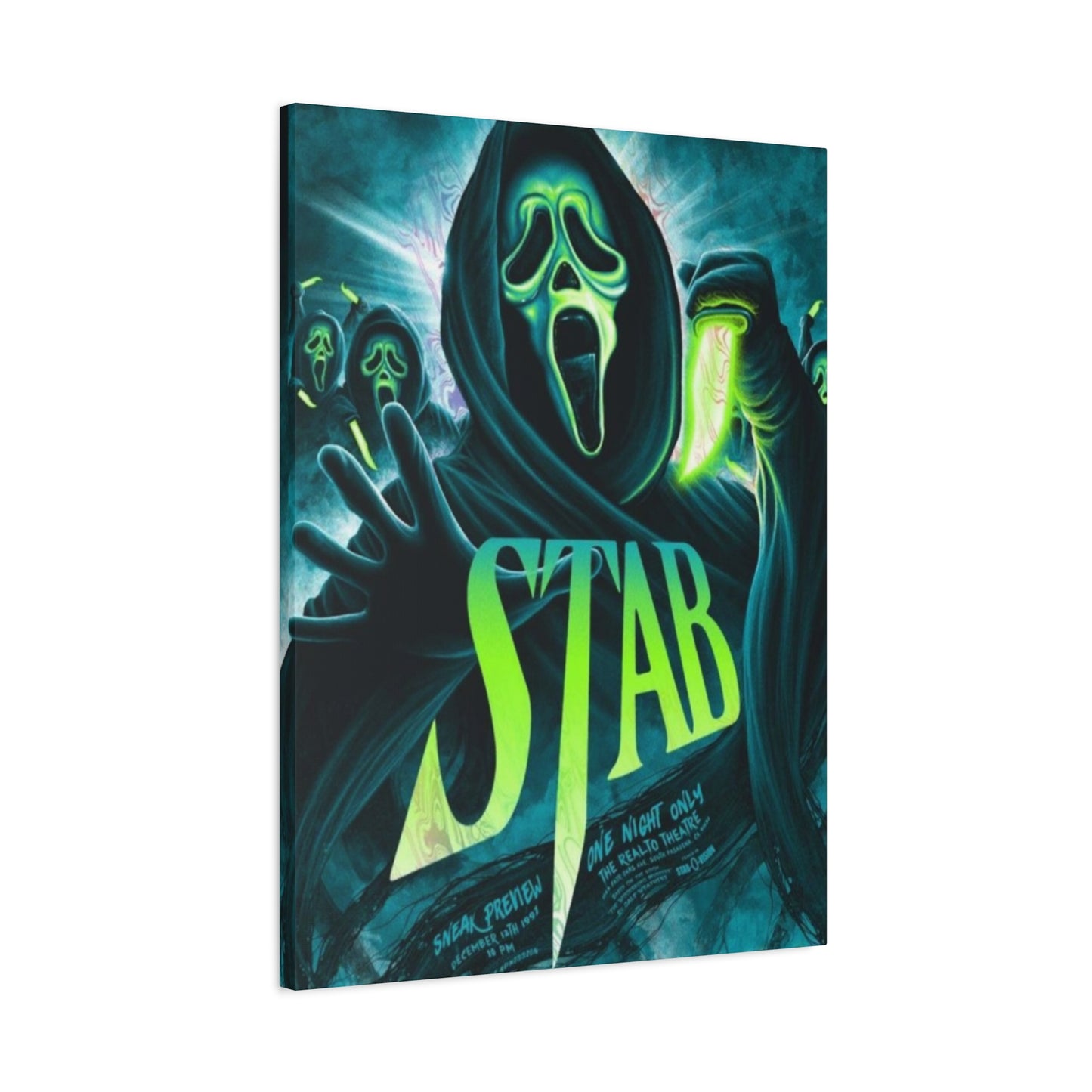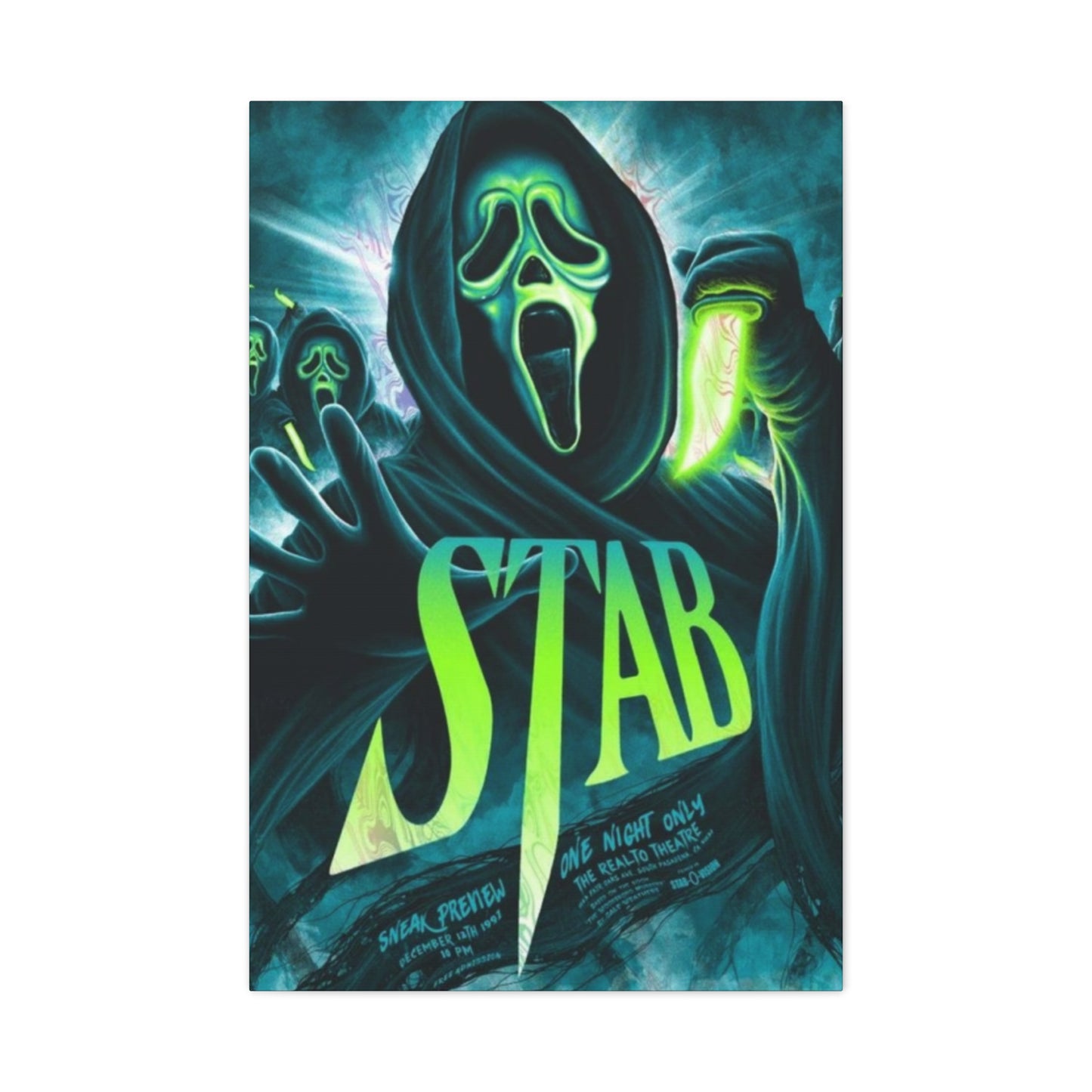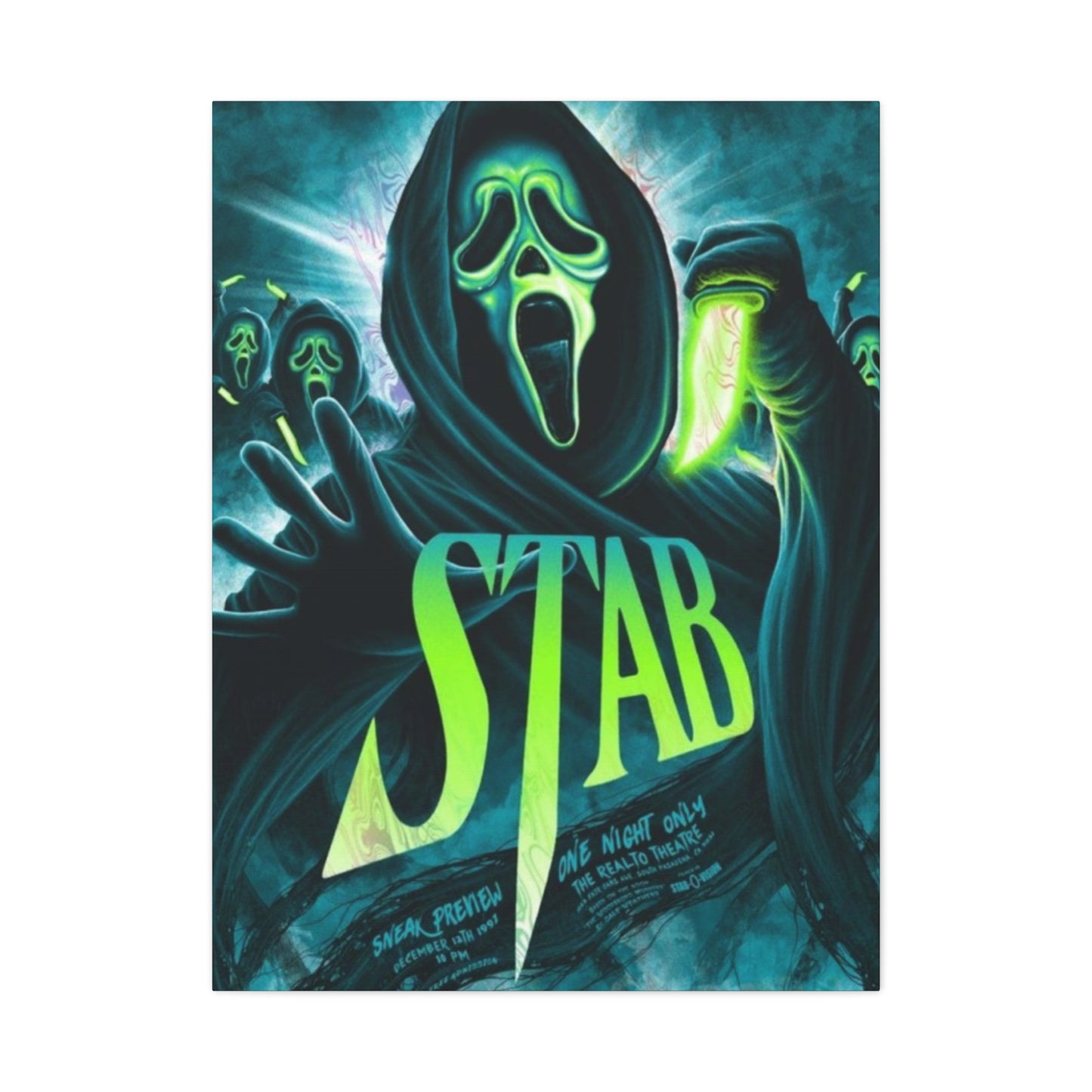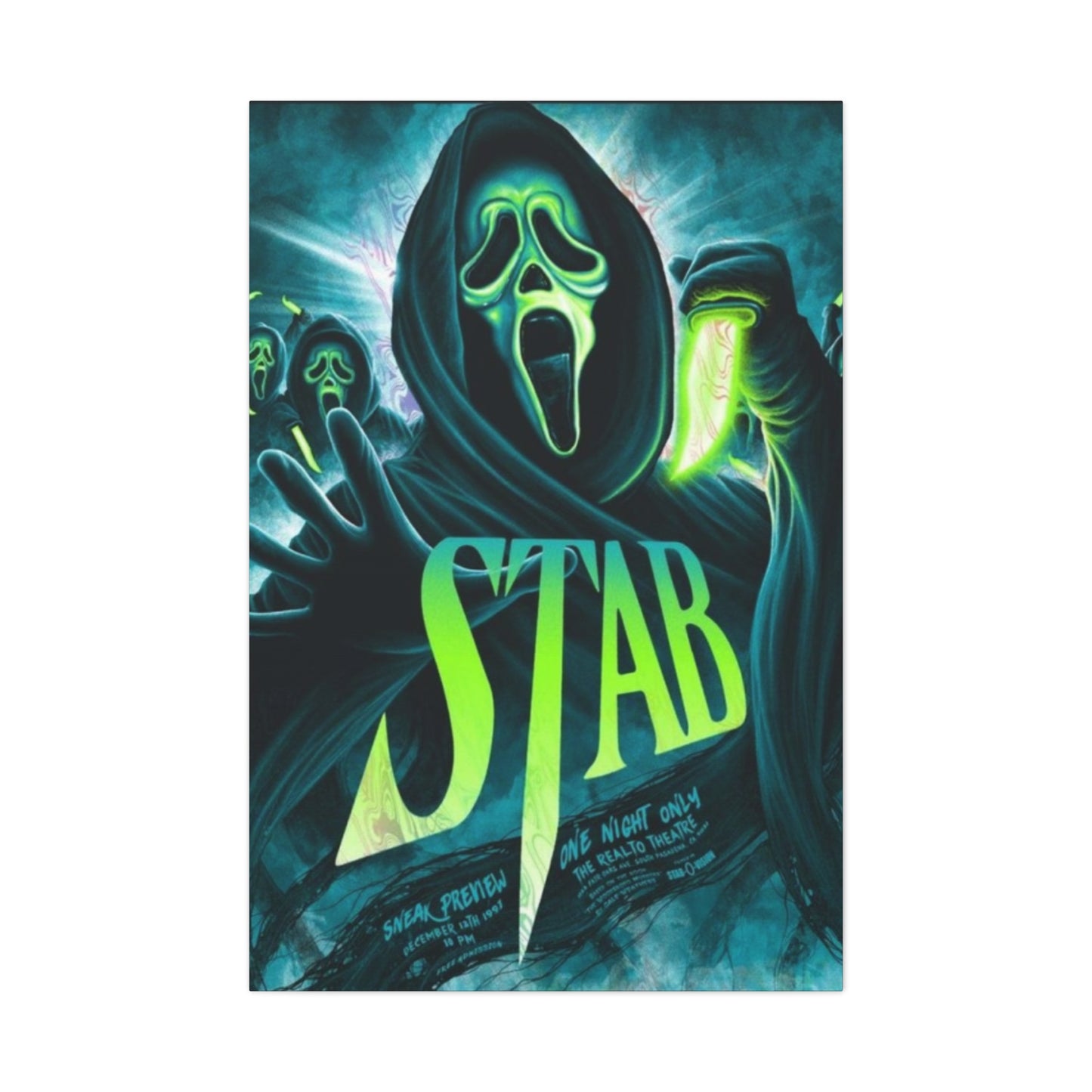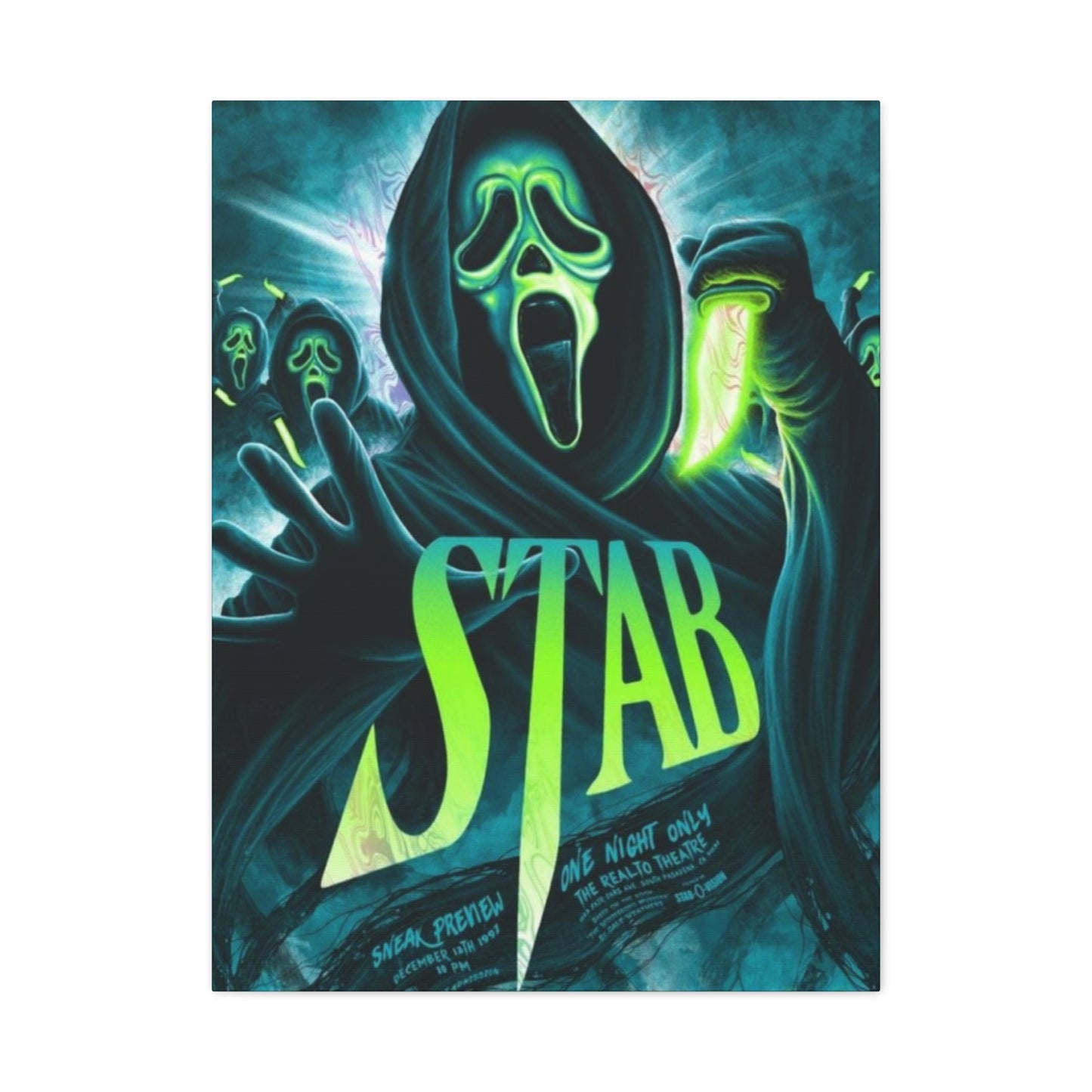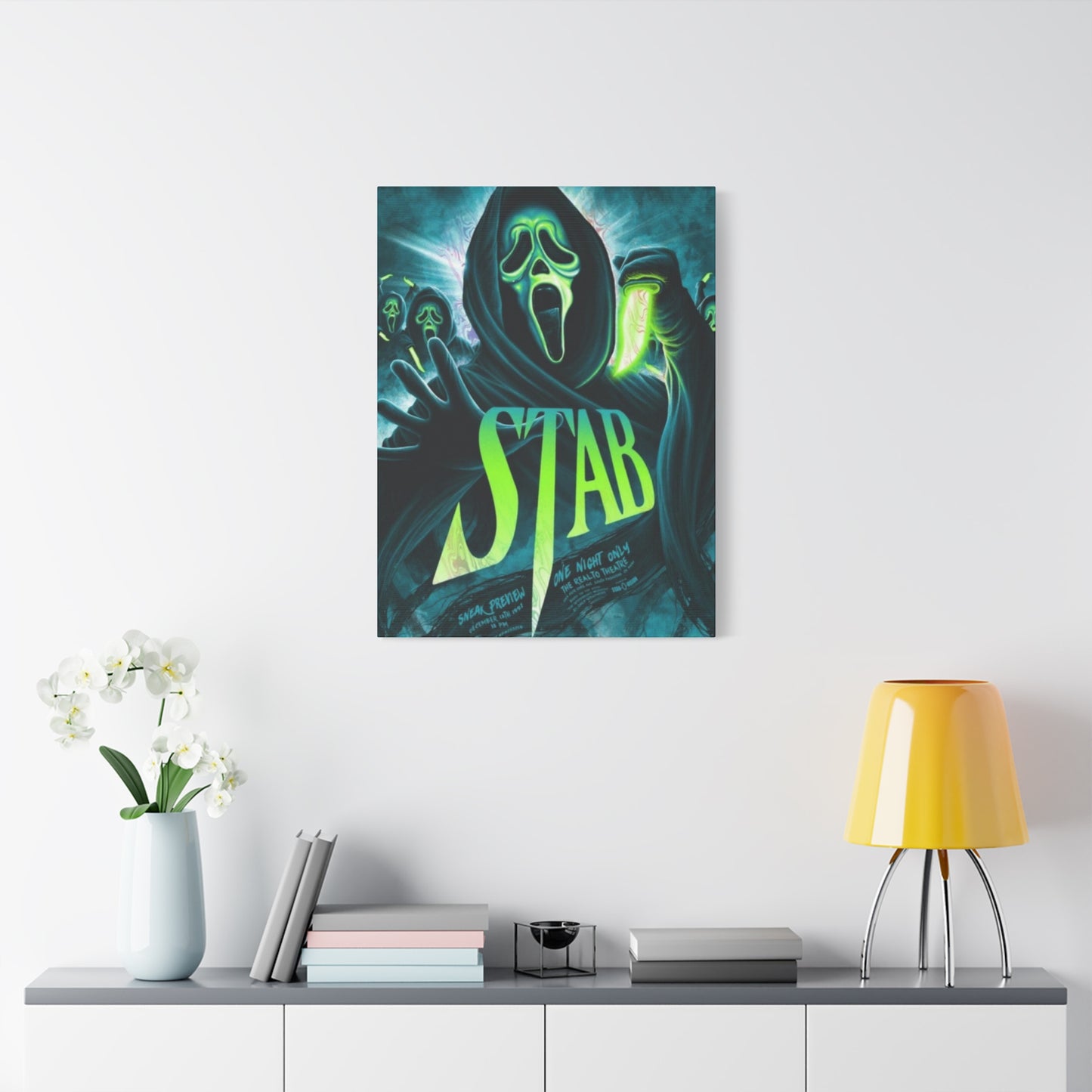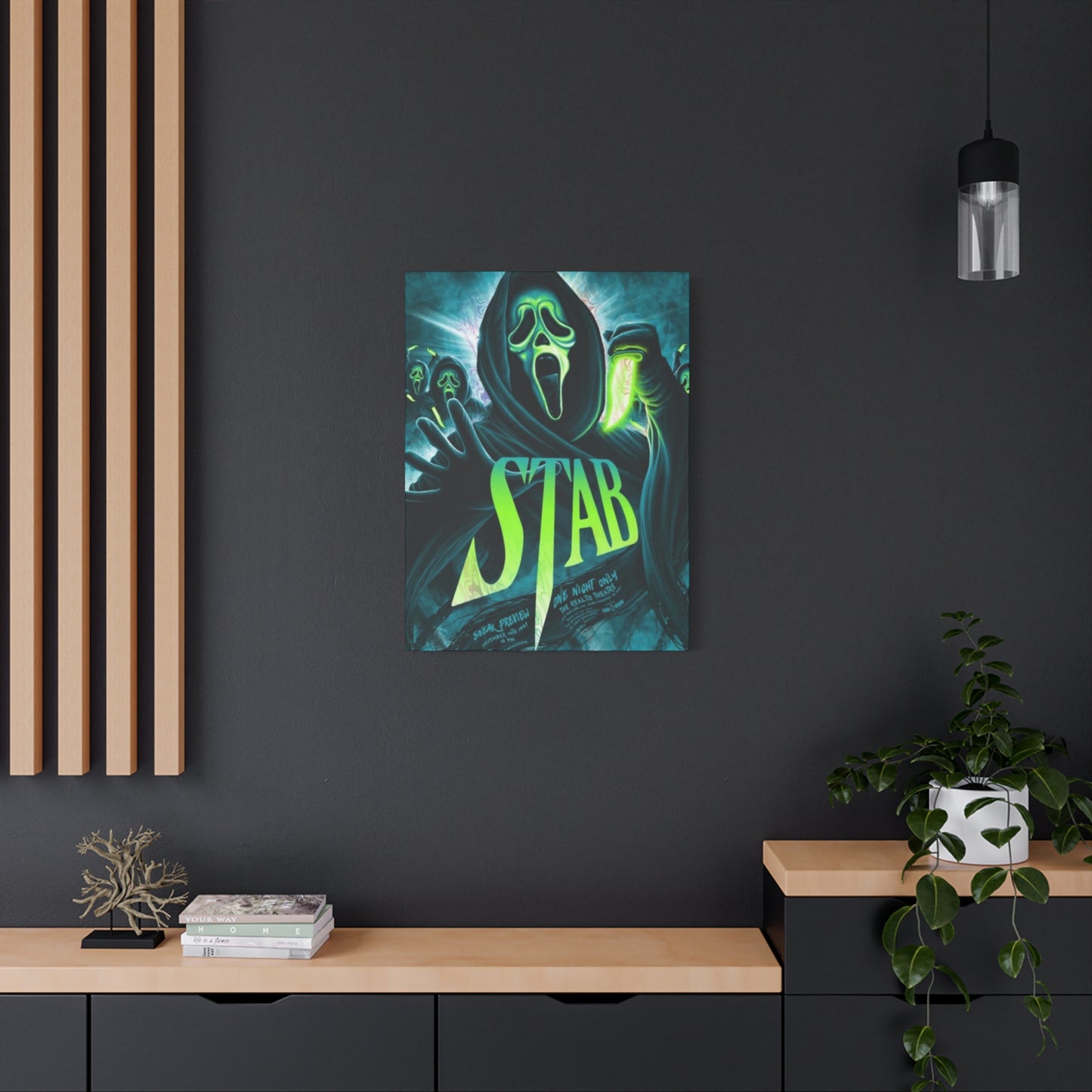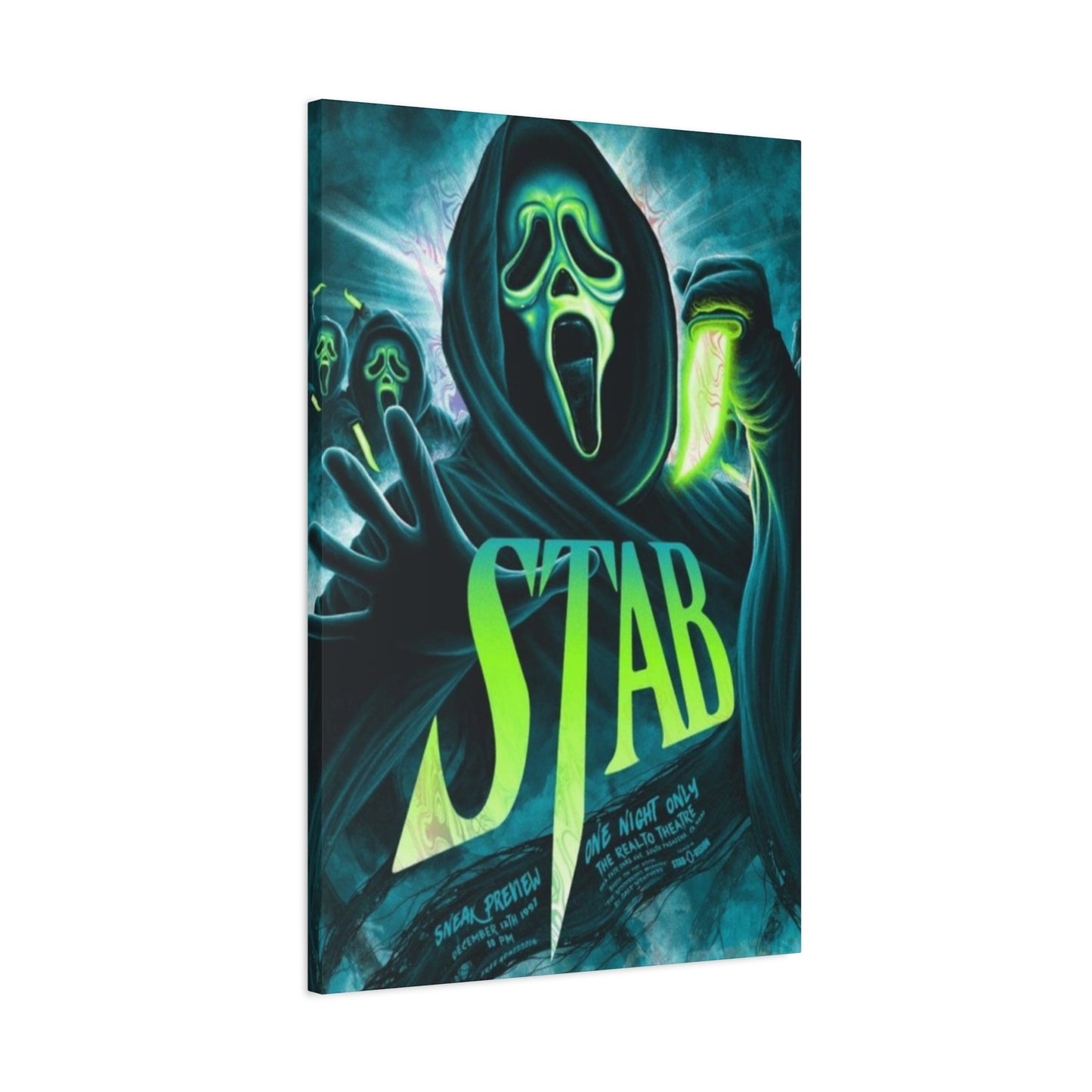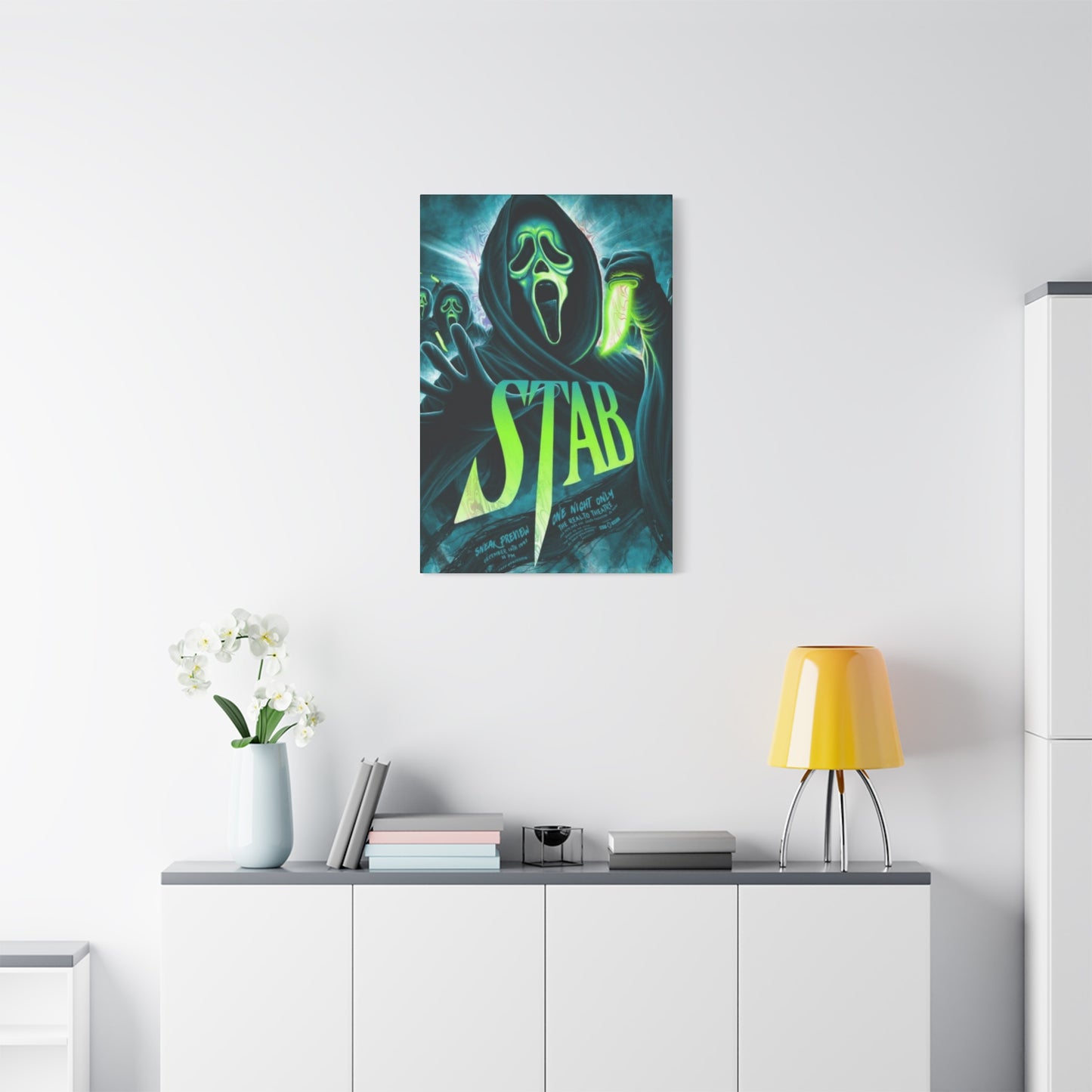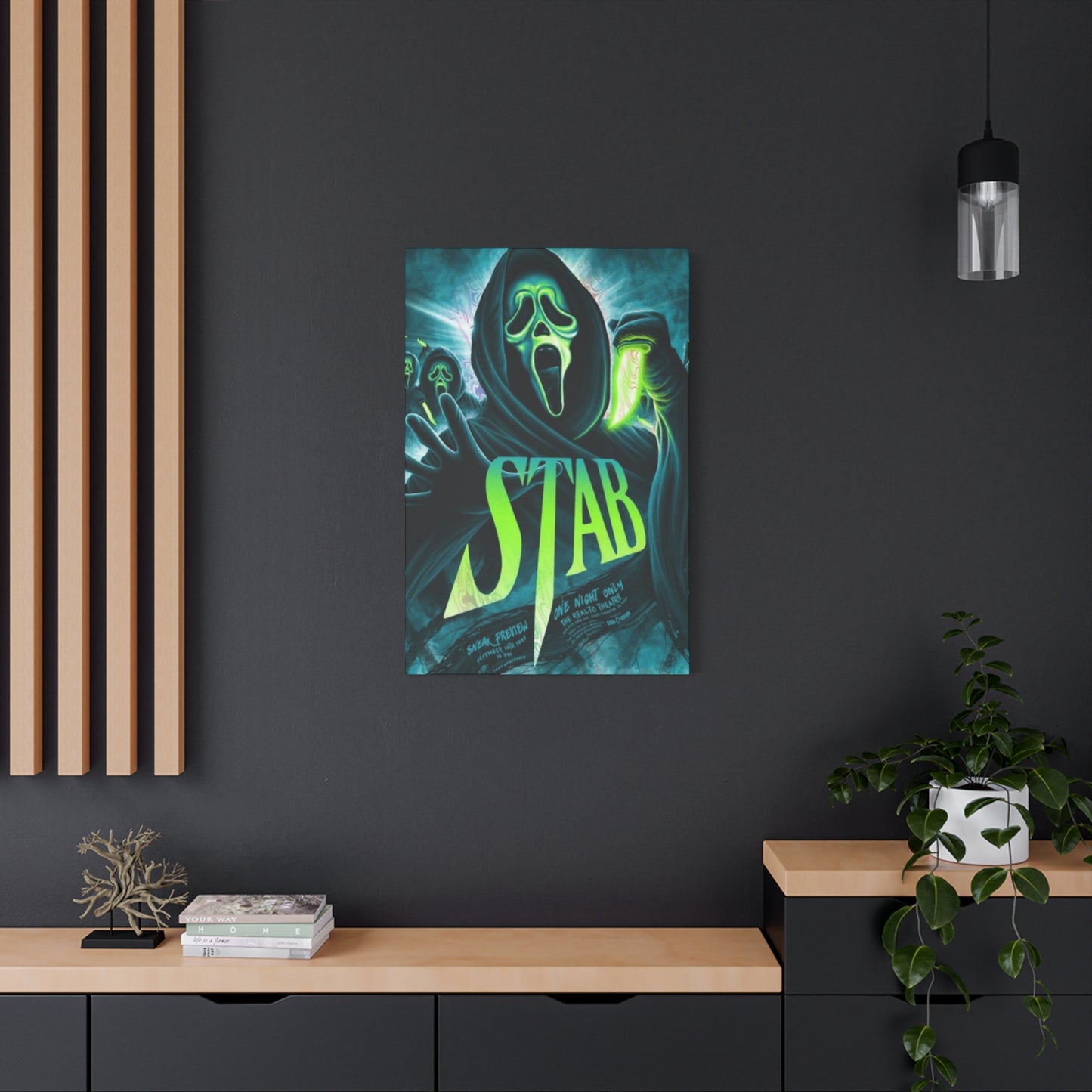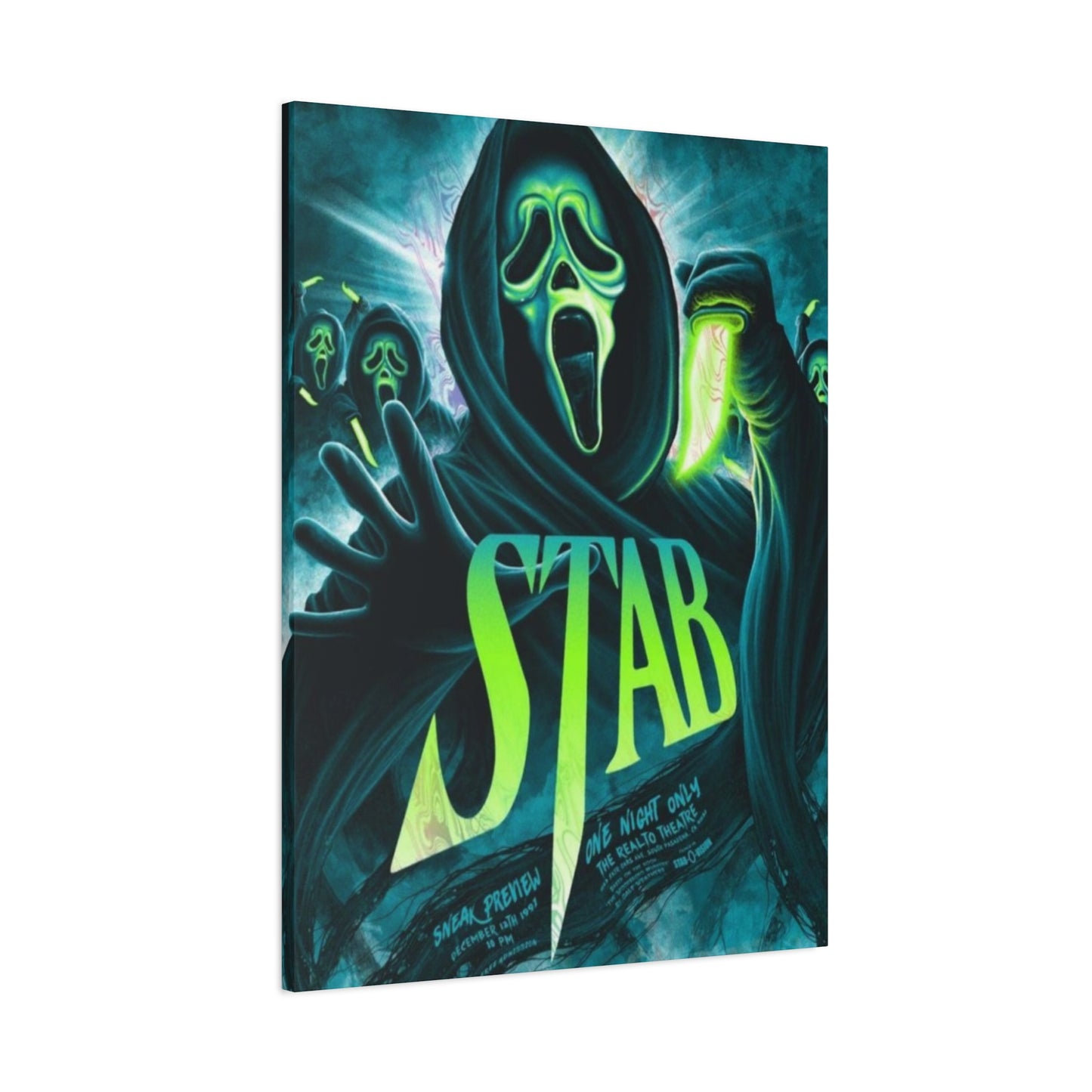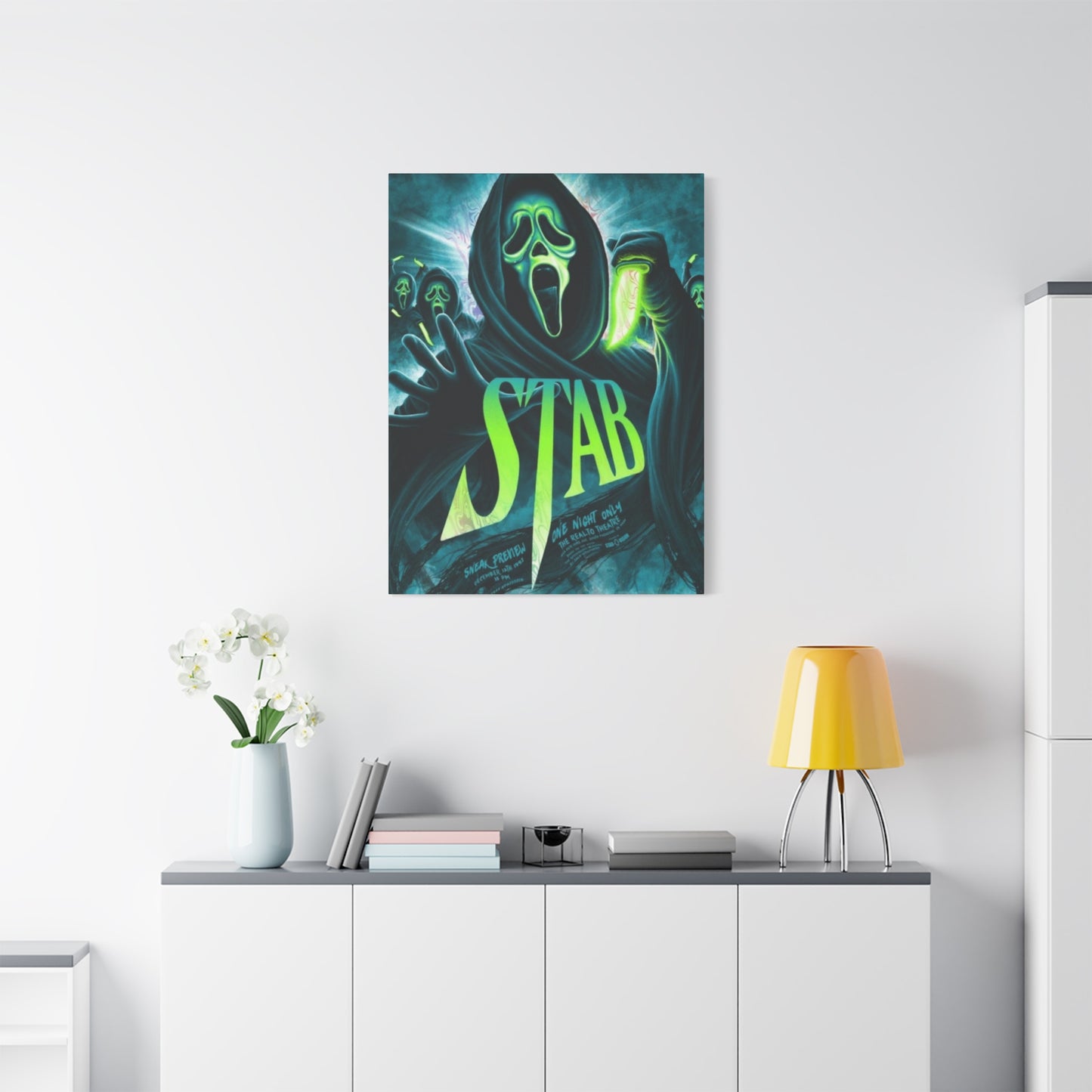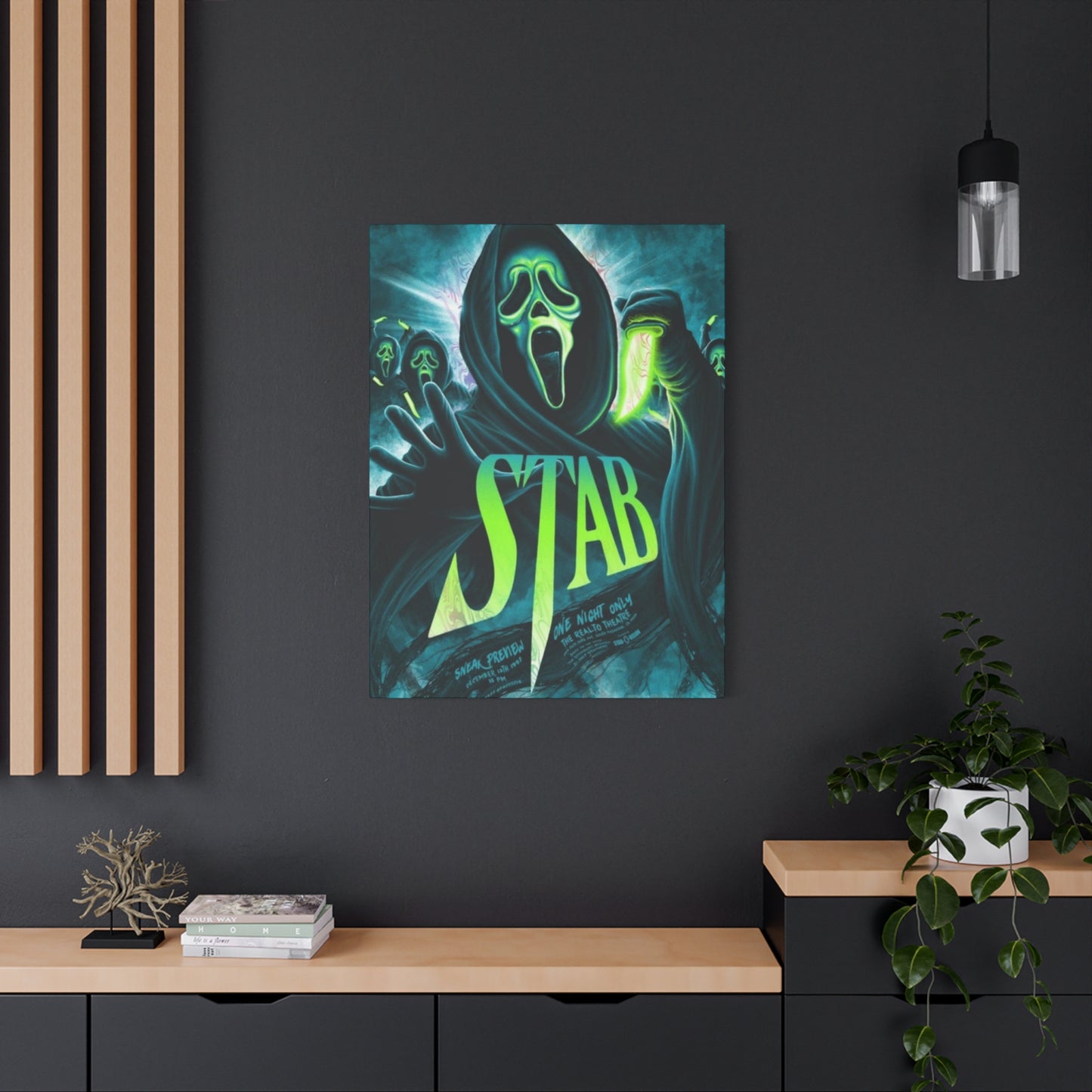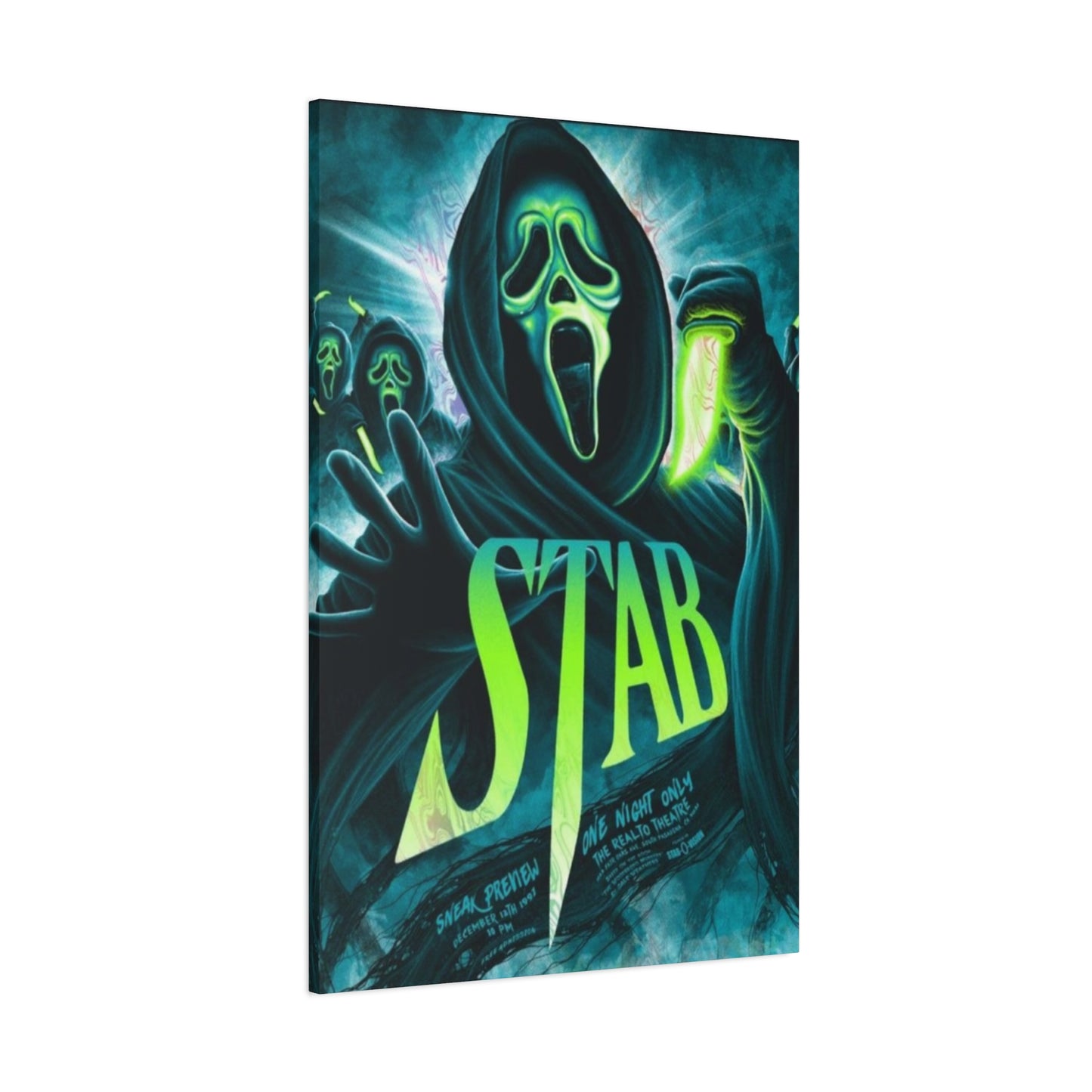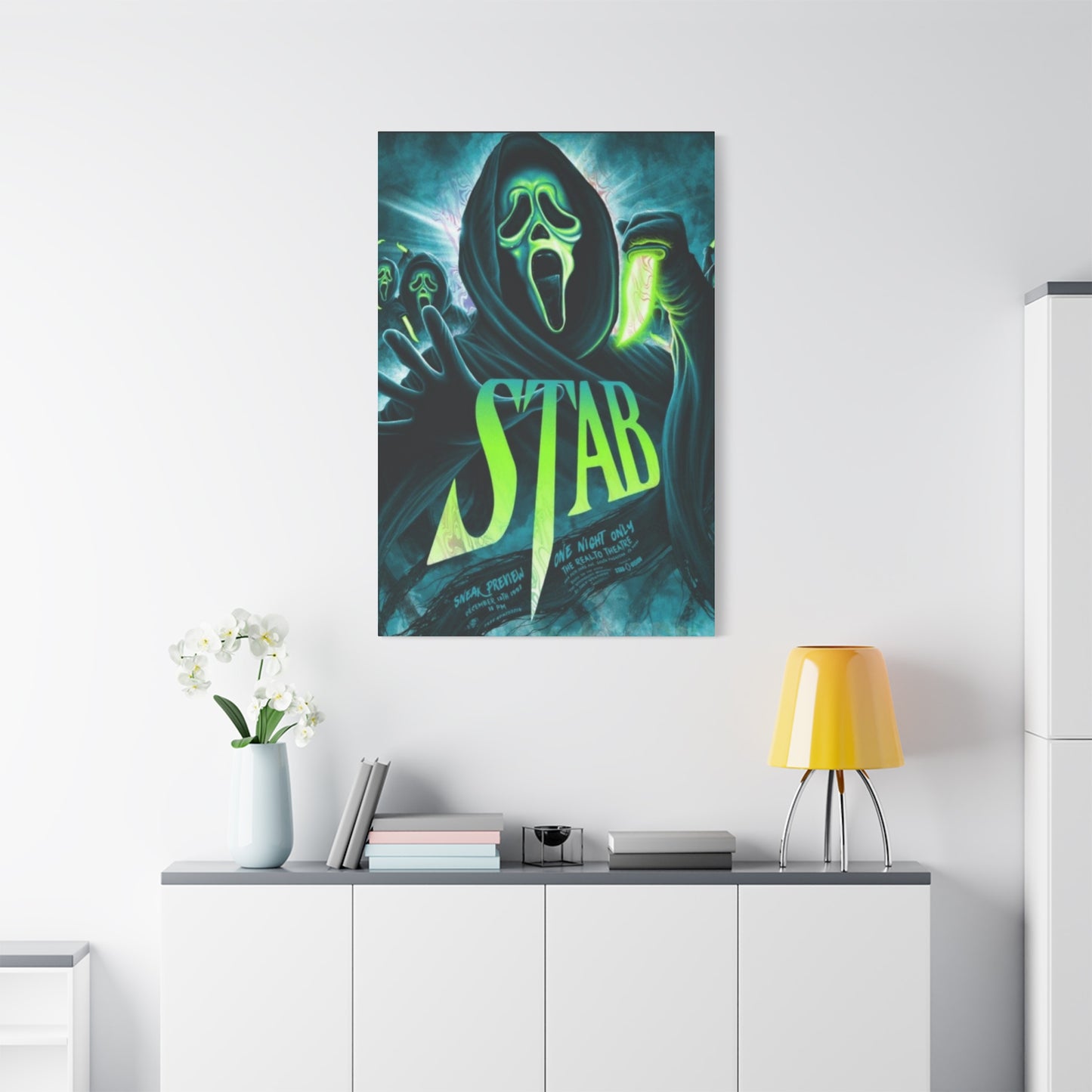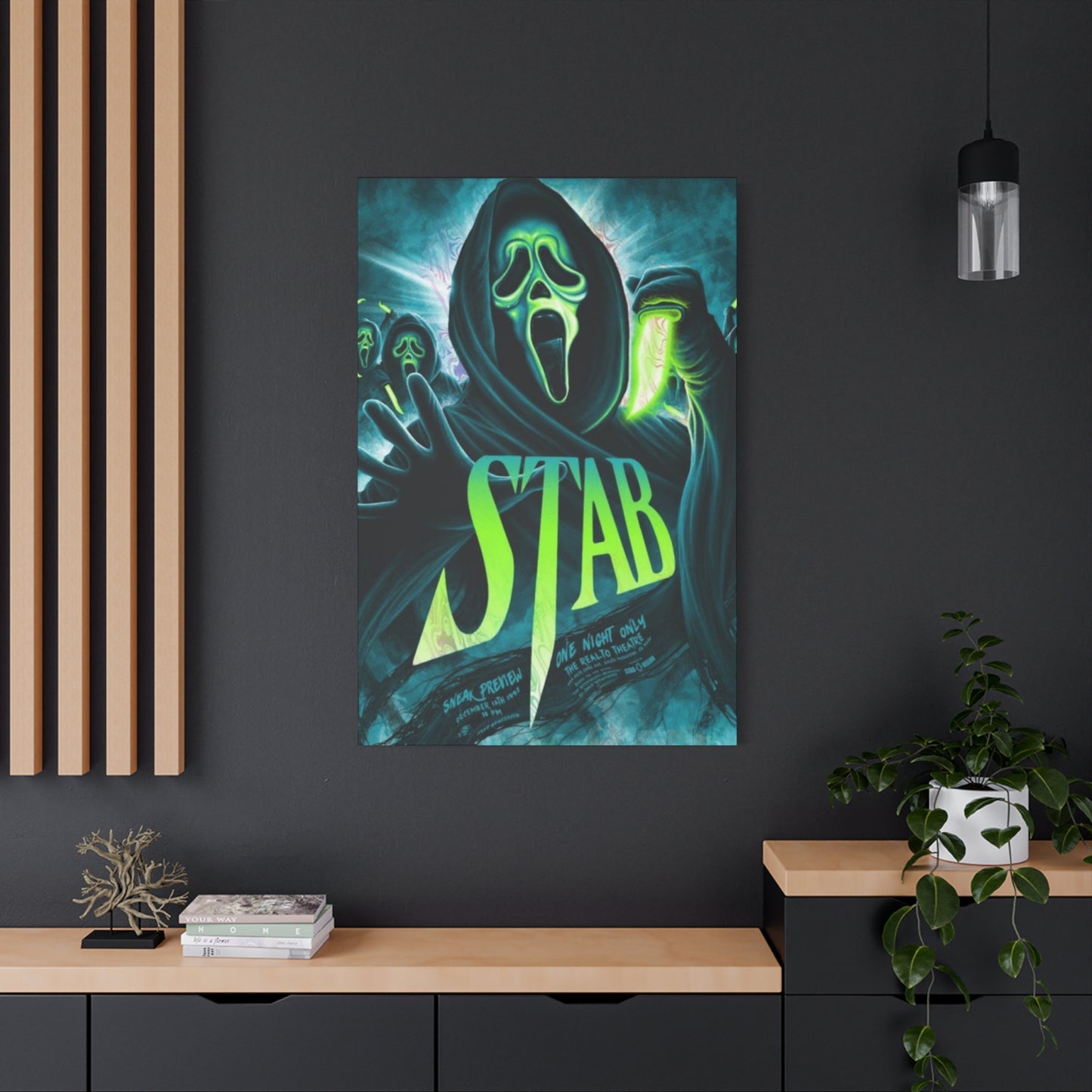The Definitive Collector's Chronicle of Stab Horror Movie Poster Wall Art Canvas Prints
The world of cinema is filled with iconic imagery, but few are as uniquely layered as the artwork associated with the fictional 'Stab' movie franchise. Born from the self-referential universe of the 'Scream' saga, 'Stab' represents a movie-within-a-movie, a parody that lovingly dissects the horror genre while simultaneously becoming a part of its lore. For devoted fans, this meta-narrative is a significant part of its appeal. This appeal has transcended the screen, finding a vibrant and enduring home in the realm of physical media and home decor. Specifically, Stab horror movie poster wall art canvas prints have become a powerful medium for fans to express their appreciation for this intricate world. These are not just decorations; they are statements.
They represent a deep understanding of horror history, a love for cinematic satire, and an appreciation for an antagonist, Ghostface, who is as much a symbol of the genre's rules as he is a terrifying slasher. Choosing to hang a 'Stab' poster on your wall is an act of curating a personal space that celebrates this clever, thrilling, and endlessly entertaining corner of horror cinema. It’s an acknowledgment that sometimes, the most fascinating stories are the ones that know they are stories. This exploration delves into every facet of these unique art pieces, from their conceptual origins and artistic merit to the practical aspects of choosing, displaying, and preserving them as cherished parts of a horror aficionado’s collection.
Deconstructing the Legend: What is the 'Stab' Franchise?
To fully appreciate the art, one must first understand the source. The 'Stab' franchise is a fictional series of horror films that exists within the universe of the 'Scream' movies. It was first introduced in 'Scream 2' as a cinematic adaptation of the events of the first 'Scream' film, based on the book "The Woodsboro Murders" by Gale Weathers. This concept immediately established a meta-commentary that would become the hallmark of the 'Scream' saga. The 'Stab' movies serve as a direct reflection, and often a satirical exaggeration, of the slasher tropes that 'Scream' itself deconstructs. The posters for these fictional films, therefore, are not just marketing materials for a non-existent product; they are critical pieces of world-building.
They capture the essence of how Hollywood, within that universe, would package and sell the very real trauma and terror experienced by the characters. Each 'Stab' sequel, mentioned throughout the 'Scream' series, pushes the parody further, exploring concepts like time travel, reboots, and "elevated horror," all of which would be reflected in their theoretical promotional art. The existence of Stab horror movie poster wall art canvas prints in the real world is a testament to the power of this fictional creation. Fans have embraced the in-universe lore so completely that they desire to bring a piece of it into their own reality, blurring the lines between the world on screen and the world of the audience in a way that is perfectly in tune with the spirit of the 'Scream' franchise.
The Cultural Echo of 'Scream' and the Birth of a Fictional Icon
The late 1990s were a transformative period for the horror genre, and Wes Craven's 'Scream' was the catalyst. It revitalized the slasher film by infusing it with wit, self-awareness, and characters who understood the "rules" of surviving a horror movie. This clever approach created a cultural shockwave, influencing countless films and television shows that followed. The ripple effect of this influence is most perfectly encapsulated by the 'Stab' franchise. 'Stab' became the tangible result of 'Scream's' deconstruction. It wasn't just a background detail; it was a recurring plot device, a source of conflict, and a mirror held up to the genre's excesses.
The iconography of 'Stab', particularly its menacing Ghostface killer, became almost as recognizable as the "real" thing. This cultural echo is the reason why 'Stab' posters resonate so deeply. They tap into the nostalgia for 90s horror while also celebrating the intelligent filmmaking that set 'Scream' apart. Owning a 'Stab' canvas print is more than just owning a piece of movie memorabilia; it is owning a tribute to a turning point in cinematic history. It signifies an appreciation for the moment when horror became self-aware, inviting the audience to be in on the joke. The art serves as a permanent reminder of the film that changed the game, and its brilliant, fictional offspring that continues to haunt the imaginations of fans.
A Legacy in Ink: The Evolution of Horror Movie Poster Art
Horror movie posters have a rich and storied history, evolving from the sensational, lurid illustrations of the 1930s and 40s to the stark, minimalist designs of the modern era. In the golden age, posters for films like 'Dracula' and 'Frankenstein' relied on dramatic, gothic imagery and shocking taglines to entice audiences. The 70s and 80s, the heyday of the slasher, saw the rise of iconic, artist-driven posters for films like 'Halloween' and 'A Nightmare on Elm Street', where a single, terrifying image could burn itself into the public consciousness. These posters were not just advertisements; they were works of art that set the tone and promised a specific kind of terror.
The 'Stab' posters, as a meta-creation, are designed to fit seamlessly into this legacy. They emulate the styles prevalent during their fictional release dates. An early 'Stab' poster might mimic the photo-heavy, star-studded layouts of the late 90s, while a poster for a later, grittier reboot like 'Stab 8' might adopt a more textured, art-house aesthetic. This evolution is a key part of their appeal. A Stab horror movie poster wall art canvas print is a piece of a fabricated history, a pastiche that honors the artistic trends of the genre. It allows collectors to display a piece that feels both familiar and new, a tribute to the entire visual history of cinematic fear, all filtered through the clever lens of the 'Scream' universe.
The Psychology of Fear: Why We Adorn Our Homes with Horror
The decision to display images of terror and dread within the sanctuary of one's home may seem paradoxical, yet it speaks to a complex psychological relationship with the genre. For many, horror is a safe way to confront fear. It provides a controlled environment in which to experience adrenaline, suspense, and anxiety, all without any real-world threat. Hanging a 'Stab' poster on the wall is an extension of this controlled confrontation. The image of Ghostface, knife raised, is stripped of its immediate danger and transformed into an object of aesthetic appreciation. It becomes a symbol of the thrill, not the threat.
Furthermore, horror fandom often fosters a strong sense of community and identity. Displaying horror art is a way of signaling one's membership in this community, a visual shorthand that says, "I appreciate the artistry, the history, and the emotional power of this genre." For fans of 'Scream', the 'Stab' posters carry an additional layer of intellectual appeal. They represent not just fear, but the deconstruction of fear. They are a nod to the cleverness of the narrative, making the act of displaying them a celebration of both visceral thrills and smart storytelling. The canvas print becomes a focal point for this identity, a daily reminder of the stories and ideas that excite and fascinate the owner.
Dissecting the Design: The Visual Language of 'Stab' Posters
The visual language of 'Stab' movie posters is a carefully crafted blend of homage and parody. These designs must accomplish a dual purpose: they need to look like authentic horror movie posters from their supposed era of release, and they must also contain the subtle wit and self-referential humor that defines the franchise. Key elements are consistently employed to achieve this. The Ghostface mask is, of course, the central icon, often depicted in a dynamic, threatening pose. Its stark black and white features create immediate visual contrast and a sense of faceless, motiveless evil.
The gleaming blade of a buck knife is another recurring motif, frequently positioned to draw the viewer's eye and create a sense of impending violence. The typography is also crucial, often using distressed, sharp-edged fonts to convey a sense of danger. The color palette typically leans heavily on blacks, reds, and deep blues, classic horror colors that evoke darkness, blood, and night. However, where the 'Stab' posters excel is in their meta-textual details. A tagline might cleverly reference a rule of horror, or the composition might mimic a famous poster from a real-world slasher film. Analyzing a Stab horror movie poster wall art canvas print reveals these layers of meaning, making it a piece of art that rewards repeat viewing and a deep knowledge of the genre it so lovingly satirizes.
Beyond Paper: The Superiority of Canvas for Horror Art Prints
For decades, the standard for movie posters was glossy paper, folded or rolled and sent to theaters. While nostalgic, this medium has its limitations, including fragility, susceptibility to glare, and a tendency to crease or tear. The advent of high-quality canvas printing has offered a superior alternative for collectors and decorators, especially for a subject as visually rich as horror art. Canvas provides a tangible, textured quality that paper lacks. The weave of the fabric adds depth and a fine art feel to the image, elevating it from a simple advertisement to a piece of genuine wall decor. A Stab horror movie poster wall art canvas print benefits immensely from this.
The deep blacks of Ghostface's robes appear richer and more absolute, the crimson of a bloodstain seems more visceral, and the subtle gradients in the background have more dimension. Canvas is also far more durable. It is resistant to tearing and, when properly treated, can withstand moisture and fading from UV light far better than paper. Furthermore, the absence of a glass or acrylic front, as is common with framed paper posters, eliminates glare entirely. This ensures that the artwork can be viewed from any angle without distracting reflections, allowing the terrifying imagery to make its full, uninterrupted impact. The choice of canvas is a choice for longevity, aesthetic quality, and a more immersive viewing experience.
Stab Horror Movie Poster Wall Art Canvas Prints: A New Collector's Frontier
The world of movie memorabilia collecting has long been dominated by original theatrical posters, which can command astronomical prices and are often difficult to source. This has created a barrier for many fans who wish to own and display the art of their favorite films. The emergence of high-quality Stab horror movie poster wall art canvas prints has democratized this hobby, opening up a new and exciting frontier for collectors. These prints offer a way to own a perfect, pristine representation of the artwork without the immense cost or condition-related anxieties of vintage paper. Because 'Stab' posters are fictional, the concept of an "original" is fluid, primarily existing in the realm of fan creation and officially licensed merchandise that imagines what those posters would look like.
This unique status makes canvas prints the ideal medium for the 'Stab' collector. They are not replicas of an existing artifact but are instead the definitive realization of a piece of fictional lore. This allows collectors to focus on the artistic merit, the quality of the print, and how the piece fits into their personal space. The collection is not about rarity in the traditional sense, but about curating a gallery of meta-horror history. It’s a modern, accessible, and deeply personal way to engage with a beloved franchise, celebrating the art on its own terms and creating a collection that is both visually stunning and intellectually satisfying.
The Anatomy of a Canvas Print: Materials and Craftsmanship
Not all canvas prints are created equal. The quality and longevity of a piece of wall art are directly tied to the materials and craftsmanship involved in its creation. Understanding the anatomy of a canvas print is essential for any collector looking to invest in a piece that will stand the test of time. The process begins with the canvas itself. High-quality prints typically use a poly-cotton blend, which offers the best of both worlds: the natural, textured feel of cotton and the durability and stretch-resistance of polyester. The weight of the canvas, measured in grams per square meter (GSM), is also a key indicator of quality, with heavier weights providing a more substantial and robust base for the ink.
Next is the stretcher frame, the wooden skeleton over which the canvas is stretched. Kiln-dried pine is the industry standard, as it is resistant to warping and shrinking over time. The depth of the stretcher bars, often 1.5 inches or more, contributes to the gallery-style, three-dimensional presence of the artwork on the wall. Finally, the way the canvas is stretched and secured is a hallmark of good craftsmanship. A properly stretched canvas will be taut, with clean, neatly folded corners, a technique known as a "gallery wrap." These elements combined ensure that a Stab horror movie poster wall art canvas print is not just a picture on fabric, but a well-constructed piece of decor built to last.
Printing Perfection: Techniques That Bring Ghostface to Life
The soul of a canvas print lies in the printing process. It is the technology and technique used that transforms a digital file into a vibrant, tangible piece of art. The dominant technology for high-quality art prints is Giclée printing, a process that uses advanced inkjet printers to apply archival-grade inks onto the canvas. Unlike standard printing, Giclée uses a wider range of colors, often up to 12 different ink cartridges, allowing for incredibly precise color matching and the reproduction of subtle gradients and deep, rich tones. This is particularly crucial for horror art, where the interplay of shadow and light is paramount. For a 'Stab' poster, this means the blacks of the Ghostface costume are truly black, not a muddy grey, and the glint of the knife has a genuine metallic sheen.
The inks used in this process are also critical. Archival pigment inks are the preferred choice. These inks are composed of solid, microscopic particles of pigment suspended in a liquid carrier. When sprayed onto the canvas, the liquid evaporates, leaving the pigment bonded to the surface. This method is far more resistant to fading from UV light than standard dye-based inks, with manufacturers often rating their prints to last for 100 years or more without significant color shift. This commitment to printing perfection ensures that the terror and artistry of the 'Stab' poster remain as sharp and impactful decades from now as the day it was printed.
Choosing Your Terror: Selecting the Ideal 'Stab' Poster for Your Space
Selecting the right piece of art for any room is a personal journey, and choosing a 'Stab' poster is no exception. The decision involves balancing personal taste, the existing decor of the space, and the specific mood you wish to create. First, consider the specific 'Stab' movie poster you want. Are you drawn to the classic, 90s blockbuster feel of the original 'Stab' poster, or do you prefer the darker, more modern aesthetic of a later sequel? Each poster has a unique color palette and composition that will interact differently with your room. A poster with a lot of stark black and white might work well in a minimalist or industrial space, while one with more vibrant splashes of red could become a dramatic focal point in a more neutrally decorated room. The size and orientation of the canvas are also critical.
A large, cinematic-scale vertical poster can create a powerful statement piece in a living room or home theater with high ceilings. A smaller, horizontal design might be better suited for placement above a desk or in a hallway. Before purchasing, it's often helpful to measure the intended wall space and even tape up a paper outline of the canvas size to visualize how it will fit and interact with furniture and other decor elements. Ultimately, the ideal 'Stab' poster is one that not only celebrates your love for the franchise but also enhances and complements the environment it inhabits.
Gallery of Ghouls: A Fictional Retrospective of 'Stab 1' Poster Art
The theatrical poster for the original 'Stab' movie, as envisioned within the 'Scream' universe, would have been a masterclass in late 90s marketing. It needed to introduce a new slasher icon to a fictional audience already familiar with the real-world horrors of the Woodsboro murders. The design would likely have followed the "floating heads" trend of the era, featuring prominent, dramatic portraits of the actors playing the key roles, including Tori Spelling as Sidney Prescott. Their expressions would be a mixture of fear and defiance, arranged in a carefully constructed hierarchy. Dominating the composition, however, would be the haunting, larger-than-life image of the Ghostface mask, its empty eyes staring directly at the viewer.
The background would likely be a dark, moody depiction of the fictional town of Woodsboro, perhaps with the iconic Macher house silhouetted against a stormy sky. The color palette would be heavy on blues, blacks, and greys, punctuated by the stark white of the mask and a shocking splash of crimson in the title treatment. The title itself, 'Stab', would be rendered in a sharp, metallic font, possibly with a knife blade integrated into one of the letters. The tagline would be simple yet effective, something like: "Based on the terrifying true story." This design, when rendered as a Stab horror movie poster wall art canvas print, captures a perfect snapshot of a specific moment in horror history, blending real-world design trends with a rich fictional lore.
The Bloodier Sequel: Analyzing the 'Stab 2' Theatrical Poster
Following the fictional success of the first film, the poster for 'Stab 2' would have had a different objective: to promise a bigger, bloodier, and more intense experience. The design would reflect the sequel's common "more is more" philosophy. The floating heads of the cast would likely return, but this time they would be more numerous, hinting at a higher body count and an expanded cast of potential victims and suspects. The central image of Ghostface would be even more prominent and menacing, perhaps depicted in motion, knife lunging forward, breaking the plane of the design to create a more dynamic, three-dimensional effect. A key visual element for the 'Stab 2' poster would be the incorporation of the movie-within-a-movie theme.
We might see a subtle background element depicting a movie theater, with Ghostface looming over it, symbolizing the film's premiere massacre setting. The color scheme would likely introduce more aggressive reds, not just in the title, but as a background wash or stylistic element, visually reinforcing the promise of increased violence. The tagline would have to be self-aware, playing on the rules of sequels, something like: "The body count is always bigger in the sequel." A canvas print of this imagined poster would appeal to fans who love the meta-commentary of 'Scream 2', capturing the film's satirical take on Hollywood's love for escalating its successful formulas. It represents a franchise becoming self-aware of its own fictional legacy.
Back to the Beginning: The Time-Bending Art of 'Stab 3'
The poster for 'Stab 3: Return to Woodsboro' would have presented a unique marketing challenge, as the fictional film was a prequel that was also a sequel, dealing with events before the original 'Stab'. The poster art would need to communicate this complex, time-bending narrative. Visually, this could be achieved through a fractured or layered composition. We might see a central image of the new cast of 'Stab 3' overlaid with shadowy, ghost-like images of the original characters from the first film, suggesting that the past is literally haunting the present. The Ghostface mask could be depicted differently, perhaps with a more vintage, aged look to signify the story's connection to the past.
The color palette might employ sepia tones or a faded, desaturated look for the background elements, contrasted with the sharp, modern colors of the foreground. The setting of Hollywood, central to 'Scream 3', would also be a key visual. The poster could incorporate elements like film reels, studio lights, or the Hollywood sign into the background, grounding the horror in the world of filmmaking itself. The tagline would need to be clever and paradoxical, such as: "The first scream was the last thing you'll hear." This poster, as a canvas print, would be a conversation piece, its complex design inviting viewers to unravel the layers of its meta-narrative, perfectly mirroring the convoluted and revelatory plot of the film it represents.
A New Decade, New Rules: The Visuals of 'Stab 4'
By the time the fictional 'Stab 4' was released, the horror landscape within the 'Scream' universe would have changed. The poster would need to reflect a shift in trends, moving away from the crowded compositions of the 90s towards a more minimalist and conceptually driven design. This poster would likely focus on a single, powerful image. A stark, close-up shot of the Ghostface mask, but perhaps rendered in a new, unexpected way—made of shattered glass, or with a social media feed reflected in its eyes, hinting at the film's commentary on technology and fame. The cast's faces might not be present at all, or if they are, they would be small, almost insignificant figures at the bottom of the poster, dwarfed by the looming threat of the killer.
The color scheme would be muted and desaturated, relying on texture and shadow rather than bright colors to create impact. Typography would be clean, modern, and understated, a far cry from the stylized fonts of the earlier films. The tagline would be sharp and cynical, reflecting the new decade's horror sensibilities: "New decade. New rules. Same blade." A canvas print of the 'Stab 4' poster would appeal to those with a modern aesthetic, representing a more "grounded" and "gritty" take on the franchise, in line with the reboot culture it was satirizing. It’s a design that would feel sleek, intelligent, and subtly menacing.
Rebooting the Terror: Marketing 'Stab 5' Through its Poster
The poster for 'Stab 5' would be the quintessential "re-quel" poster, a design intended to honor the original while introducing a new generation. The marketing logic dictates a strong visual link to the very first film. The composition might directly homage the 'Stab 1' poster, but with a crucial twist. Instead of the original cast, we would see the new, younger actors, but their poses and placement would mirror their predecessors. The legacy characters, the fictionalized versions of Sidney, Gale, and Dewey, would be given a place of honor, perhaps shown slightly in the background or as stylized silhouettes, passing the torch. The most striking element would be the treatment of Ghostface.
We might see two masks, an old, weathered one and a new, pristine one, symbolizing the connection between the new killer and the original. The color palette would be a modern interpretation of the classic, using the same blues and blacks but with higher contrast and a digital sheen. The tagline is key here, and it would need to speak directly to the re-quel concept: "The killer is on someone's family tree." As a Stab horror movie poster wall art canvas print, this piece would be rich with narrative, a visual representation of legacy, nostalgia, and the cyclical nature of horror, making it a favorite for fans who appreciate the entire arc of the franchise.
Based on a True Story... Again: The Meta-Art of 'Stab 6'
The premise of 'Stab 6' within the 'Scream' universe would likely push the meta-commentary to its limits, perhaps being a film that is itself about the making of a 'Stab' movie. Its poster would need to reflect this "movie-within-a-movie-within-a-movie" concept. The design could be incredibly clever, styled to look like a clapperboard or a page from a screenplay. The title, 'Stab 6', might be handwritten with director's notes in the margins. The main image could be a shot of a film set, with Ghostface standing menacingly behind a camera, blurring the line between the filmmaker and the killer.
Alternatively, the poster could feature a highly stylized image of the Ghostface mask being reflected in the lens of a movie camera, the ultimate symbol of horror observing itself. The cast photos might be presented as headshots pinned to a corkboard, as if for casting. The color palette would be more desaturated, almost documentary-style, to enhance the "behind the scenes" feel. The tagline would be overtly self-referential: "This time, the director's cut is you." A canvas print of this poster would be the ultimate conversation starter for a true 'Scream' aficionado. It’s a design that eschews traditional horror imagery for a more intellectual, conceptual approach, celebrating the franchise's defining characteristic: its unparalleled self-awareness.
Stab 7's Cinematic Gamble: A Poster for a Movie-Within-a-Movie
'Scream 4' introduced us to the opening of 'Stab 7', a film that featured time travel, a concept so absurd it signaled the creative bankruptcy of the fictional franchise. The poster for 'Stab 7' would have to embrace this high-concept, science-fiction-infused horror. The artwork would be a departure from anything seen before. The central image might show Ghostface stepping out of a shimmering, futuristic portal, knife in one hand and perhaps a piece of anachronistic technology in the other. The background wouldn't be Woodsboro, but a chaotic collage of different time periods—a glimpse of the 1950s, the Wild West, or a futuristic cityscape.
The color palette would be vibrant and chaotic, with neon blues and purples from the time portal contrasting with the historical settings. The typography would likely be updated to a sleek, sci-fi font, moving away from the traditional horror aesthetic. The cast would be shown reacting not just with fear, but with confusion, underscoring the bizarre premise of the film. The tagline would be suitably over-the-top and nonsensical: "The past is calling. Hang up." As a Stab horror movie poster wall art canvas print, this piece would represent the moment the fictional franchise "jumped the shark," making it a humorous, almost ironic piece of decor for fans who appreciate the deepest cuts of the 'Scream' lore.
The Fan-Fueled Legacy: Imagining the Poster for 'Stab 8'
Mentioned in the 2022 'Scream' film, 'Stab 8' was a controversial "re-quel" that divided the fictional fanbase, helmed by a new, hip "elevated horror" director. The poster would need to look completely different from its predecessors, signaling a break from tradition and a move towards a more art-house sensibility. The design would be starkly minimalist. Forget floating heads or dynamic action poses. The poster might be a simple, textured background with a single, symbolic object at its center—perhaps the Ghostface mask cast in chrome, or a single, bloody knife resting on a pristine white surface. The title, 'Stab', might even omit the number 8, a common trend in modern reboots seeking to present themselves as a fresh start.
The color palette would be severely restricted, perhaps to only black, white, and a single accent color. The names of the actors would be listed in a small, clean, sans-serif font at the bottom, prioritizing artistic mystique over star power. The tagline would be pretentious and vague, typical of the "elevated horror" it is parodying: "It's not about who's behind the mask. It's about the mask itself." This canvas print would be the perfect choice for a horror fan with a minimalist, modern home decor style. It’s a subtle, sophisticated piece that speaks volumes about the evolution and intellectualization of the horror genre, both real and fictional.
The Unseen Collection: Variant Posters and International Designs
In the real world, major film releases are accompanied by a variety of promotional materials, including teaser posters, character posters, and unique designs for international markets. It's fascinating to imagine what this "unseen collection" would look like for the 'Stab' franchise. A teaser poster for 'Stab' would likely be incredibly simple: a black background with just the iconic, screaming mask and a release date. Character posters would isolate each of the main characters, showing them in a moment of terror or defiance, each poster perhaps having a unique color tint. International posters offer the most creative possibilities.
A Japanese 'Stab' poster, for instance, might use a completely different, more dynamic illustration style, possibly incorporating elements of J-horror aesthetics with frantic typography. A Polish poster could be highly abstract and metaphorical, a tradition in that country's celebrated poster art, focusing on the symbolism of the mask or the knife rather than the characters. Imagining these variants allows fans to expand the fictional universe even further. A collector could create a whole gallery wall of these hypothetical designs, showcasing a Stab horror movie poster wall art canvas print of a minimalist teaser next to a vibrant international version. This allows for an even deeper level of personal curation, creating a collection that feels like a genuine, comprehensive retrospective of a global cinematic phenomenon that never actually was.
The Power of Typography: How Fonts Create Fear
The choice of font in a horror movie poster is a subtle but powerful tool for creating a specific mood. The typography on the 'Stab' posters is no exception; it's a key ingredient in their believability and effectiveness. For the earlier, 90s-era 'Stab' films, the title font would likely be a sharp, serif font with jagged edges, reminiscent of a knife's blade. Think of fonts like Trajan, but distorted and distressed. This style communicates a sense of classic, almost epic horror, but with a violent, modern twist. The letters themselves become weapons. For the later, rebooted films like the imagined 'Stab 8', the typography would shift dramatically. A clean, cold, and widely spaced sans-serif font like Helvetica or Gotham would be used.
This creates a sense of detachment and clinical dread, aligning with the "elevated horror" aesthetic. The starkness of the font against a minimalist background can be just as unsettling as a more overtly aggressive typeface. Beyond the title, the font used for the tagline and credits block also contributes to the overall feel. A frantic, almost handwritten scrawl for a tagline can suggest panic and immediacy, while a standard, condensed movie credit font grounds the fictional poster in reality. When this typography is reproduced on a high-quality canvas, the texture of the print can enhance the font's design, making the sharp edges of a title seem more cutting and the clean lines of a modern font feel more stark.
A Palette of Panic: Color Theory in 'Stab' Poster Design
Color is the emotional language of poster design, capable of evoking feelings of dread, danger, and suspense before a single word is read. The 'Stab' posters, in their homage to the horror genre, would utilize a classic palette deeply rooted in the psychology of fear. Red is the most obvious and impactful color. It is the color of blood, violence, and emergency. In a 'Stab' poster, red is used as a powerful accent—in the title, as a stylistic blood spatter, or as a wash over a character's face to signal their imminent danger. Black is the color of the unknown, of darkness, and of death. It is the dominant color of the Ghostface costume and is used extensively in the backgrounds to create a sense of claustrophobia and to make other colors, like the white of the mask, pop with terrifying contrast.
White, in this context, is not the color of purity but of ghostly apparitions and the stark, bone-like quality of the mask. It’s the color of a blank slate, representing the killer's lack of identity. Blue, particularly deep navy or midnight blue, is often used to signify night, coldness, and a sense of melancholic dread. The interplay of these colors creates the signature look of the franchise. A Stab horror movie poster wall art canvas print accurately reproduces these deep, saturated colors, ensuring the carefully constructed palette has its full psychological impact when displayed on a wall.
Giants of the Genre: Influences on 'Stab's' Visual Identity
No art exists in a vacuum, and the visual identity of the fictional 'Stab' posters would be heavily influenced by the real-world giants of horror poster design. The most obvious influence would be the poster for John Carpenter's 'Halloween'. Its simple, iconic image of a menacing, knife-wielding figure combined with a stylized pumpkin is a masterclass in minimalist terror. The 'Stab' posters borrow this focus on a single, masked killer as the central visual element. Another clear influence is the poster for 'Jaws', which famously depicted the shark rising from the depths towards an unsuspecting swimmer. This "monster's-eye-view" perspective, creating a sense of impending doom for a vulnerable character, is a trope often replicated in slasher posters, including those for 'Stab'.
The crowded, star-focused layouts of 80s blockbusters like 'A Nightmare on Elm Street 2' or 'Friday the 13th: A New Beginning' would also inform the look of the earlier 'Stab' sequels, with their emphasis on a large cast of potential victims. More modern 'Stab' designs would draw from the minimalist, symbolic posters of A24 films like 'Hereditary' or 'The Witch', which prioritize atmosphere and conceptual intrigue over overt depictions of violence. By understanding these influences, a collector can appreciate a 'Stab' canvas print on a deeper level, recognizing it as a piece of a larger artistic conversation within the history of the horror genre.
Reflecting Reality: How 'Stab' Posters Mirror the 'Scream' Saga
The genius of the 'Stab' posters lies in how they serve as a funhouse mirror, reflecting and distorting the events and themes of the 'Scream' films themselves. Each 'Stab' poster is a commentary on the 'Scream' movie it appears in. For example, the fictional 'Stab' poster seen in 'Scream 2' emulates the blockbuster style of the time, mirroring how the real-life success of 'Scream' turned it from an indie hit into a major Hollywood franchise. The concept of 'Stab 3: Return to Woodsboro', featured in 'Scream 3', deals with secrets from the past, just as 'Scream 3' itself delves into the history of Sidney's mother. The poster's art would reflect this theme of haunting history.
The controversial, fan-dividing 'Stab 8' from the 2022 'Scream' directly mirrors the real-world discourse surrounding legacy sequels and "re-quels," and its minimalist, "elevated horror" poster would be a visual gag about this very trend. This symbiotic relationship makes the artwork incredibly rich for fans. A Stab horror movie poster wall art canvas print is not just a poster for a fake movie; it is a piece of meta-commentary on the real movie you love. It’s a visual representation of the franchise’s cleverness, a constant reminder of the intricate, self-referential world that Wes Craven and Kevin Williamson created. Displaying it is a way to celebrate this unique narrative structure that sets 'Scream' apart from every other slasher series.
Preserving Your Print: Essential Care for Canvas Wall Art
Investing in a quality Stab horror movie poster wall art canvas print means acquiring a piece of decor that is built to last, but proper care is essential to ensure its longevity and preserve its vibrancy for years to come. The most significant threat to any print is direct sunlight. The ultraviolet (UV) rays in sunlight can cause the archival inks to fade over time, a process known as photodegradation. Therefore, it is crucial to hang your canvas in a location where it will not be exposed to prolonged, direct sunlight. If hanging near a window is unavoidable, consider using UV-filtering blinds or curtains. Dust is another common issue.
A gentle, regular dusting with a soft, dry cloth or a feather duster is all that is needed. Avoid using water or any chemical cleaning solutions, as these can damage the ink and the protective coating on the canvas. For any stubborn dirt, a slightly damp cloth can be used with extreme care, but the canvas should never be saturated. Humidity and extreme temperature fluctuations can also affect the canvas and the wooden frame. Avoid hanging your art in areas prone to high humidity, such as bathrooms, as this can cause the canvas to sag or promote mildew growth. By following these simple maintenance steps, you can ensure that the terrifying visage of Ghostface remains a sharp, impactful, and cherished part of your home decor for a lifetime.
Creating a Thematic Sanctum: Designing a Horror-Themed Room
For the truly dedicated fan, a single canvas print may not be enough. The ultimate expression of fandom is the creation of a fully realized horror-themed room, a personal sanctum dedicated to the genre. A collection of Stab horror movie poster wall art canvas prints can serve as the perfect foundation for such a space. This room could be a home theater, a study, or a game room. The key is to build an immersive atmosphere. Start by choosing a color scheme for the walls that complements the posters. Deep reds, charcoal greys, or even a stark off-white can create a dramatic backdrop. Lighting is crucial. Use adjustable track lighting or spotlights to highlight each canvas print, treating them like exhibits in a gallery.
Dimmer switches are a must to create a spooky, cinematic ambiance for movie nights. The decor should extend beyond the walls. Consider bookshelves filled with horror novels and film theory books, display cases for Ghostface masks or other prop replicas, and perhaps a throw blanket or pillows with a subtle horror-themed pattern. The goal is to create a cohesive space that feels both curated and comfortable. The 'Stab' posters, with their meta-narrative and iconic imagery, become the intellectual and aesthetic centerpiece of the room, tying everything together and declaring the space as a true haven for a horror aficionado.
The Art of the Gallery Wall: Curating a Horror Masterpiece
A gallery wall is a fantastic way to display a collection of art, and it's an ideal method for showcasing multiple 'Stab' posters. Instead of one large statement piece, a gallery wall allows you to tell a story and explore the full fictional history of the franchise. The key to a successful gallery wall is thoughtful curation and arrangement. You could arrange the posters chronologically, from 'Stab 1' to 'Stab 8', creating a visual timeline of the series' evolution. Another approach is to mix in other related art. Pair a 'Stab' poster with a blueprint-style art print of the Macher house, a typographic print of the "rules" of horror, or even a canvas print of the real 'Scream' poster to highlight the meta-connection.
Don't be afraid to mix sizes and orientations. A large central 'Stab' poster can be anchored by several smaller, complementary pieces. Before hammering any nails, lay out your chosen prints on the floor. Experiment with different arrangements until you find a composition that feels balanced and visually interesting. Use paper templates cut to the size of each canvas to plan the layout on the wall itself. This method allows you to create a dynamic, personal, and professional-looking display that turns a simple wall into a comprehensive and fascinating exhibit of your love for one of horror's most clever and enduring sagas.
Final Reflections:
The journey through the world of Stab horror movie poster wall art canvas prints is a journey into the heart of modern horror fandom. It is an exploration that transcends simple home decor, touching upon cinematic history, psychological attachment, artistic analysis, and the very nature of what makes a story resonate so deeply that we feel compelled to make its fictional artifacts a part of our real-world lives. The 'Stab' franchise, born as a satirical echo within the 'Scream' universe, has achieved a tangible, independent existence through the passion of its fanbase.
These canvas prints are not mere reproductions; they are manifestations of a shared cultural moment, a tribute to the genius of a film series that forever changed the rules of its genre.Choosing to display a 'Stab' poster is a multi-layered statement. It is an appreciation for the slasher genre in its purest form, celebrating the iconic imagery of the masked killer and the impending dread that defines the category. Simultaneously, it is an acknowledgment of the sharp, intellectual wit that 'Scream' used to deconstruct those very tropes. It is a piece of art that is at once terrifying and clever, visceral and cerebral. The choice of canvas as the medium further elevates this appreciation, transforming a piece of ephemeral marketing into a durable, textured work of art with the gravitas and presence of a gallery piece.
The deep blacks, vibrant reds, and stark whites of the designs are given new life and permanence, ensuring that the art's impact is not diminished by time or glare.For the collector, these prints offer a unique and accessible frontier. They allow for the creation of a personal gallery that tells a story—the fictional history of a film franchise, its marketing evolution, and its satirical relationship with its parent series. From the 90s blockbuster aesthetic of the original 'Stab' to the stark, art-house minimalism of the imagined 'Stab 8', the collection serves as a microcosm of the horror genre's own visual evolution over the decades.
It is a hobby that encourages creativity, curation, and a deep engagement with the lore. Ultimately, the enduring appeal of these prints lies in their ability to serve as a constant, tangible connection to a beloved world. They are a focal point for nostalgia, a conversation starter among fellow fans, and a powerful expression of personal identity. To hang a 'Stab' poster on your wall is to keep the scream alive, to honor the legacy of Ghostface, and to celebrate the brilliant, bloody, and endlessly self-aware universe that continues to captivate audiences. It is a declaration that, for some, horror is not just something you watch—it's something you live with.

















